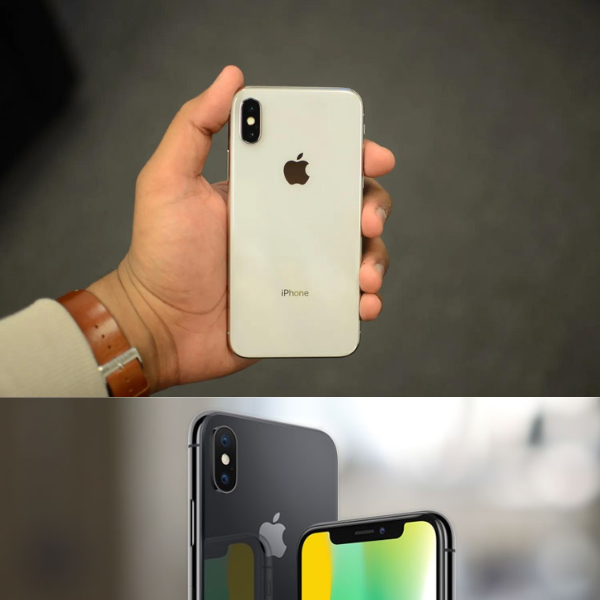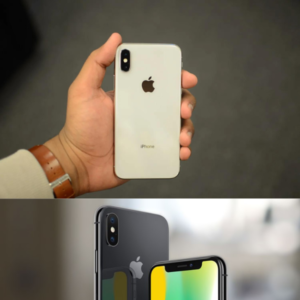iPhone X | A Revolutionary Leap in Smartphone Innovation
Introduction
In 2017, Apple celebrated the 10th anniversary of the iPhone by releasing a revolutionary device that redefined the smartphone industry. The iPhone X pronounced as “iPhone Ten,” marked a departure from the traditional iPhone design, introducing a bezel-less OLED display, Face ID facial recognition technology, and numerous other features that set the stage for the future of mobile technology. In this article, we’ll delve deep into the iPhone X, exploring its design, specifications, innovative features, impact on the industry, and its enduring legacy.
I. Design and Build
The iPhone X was a design departure from its predecessors. Apple’s relentless pursuit of innovation led to the removal of the iconic home button and the introduction of a nearly bezel-less 5.8-inch Super Retina OLED display. This edge-to-edge screen stretched from top to bottom and side to side, offering an immersive visual experience.
The device featured a stainless steel frame and glass on both the front and back, giving it a premium look and feel. The glass back allowed for wireless charging, a feature that had been absent from previous iPhone models. The iPhone X was available in two color options: Space Gray and Silver, and its sleek, symmetrical design made it a standout in the world of smartphones.
II. Display
The Super Retina OLED display on the iPhone X was a game-changer. With a resolution of 1125 x 2436 pixels and support for HDR content, it offered vibrant colors, deep blacks, and excellent contrast. This was a significant step up from the LCD displays used in earlier models, and it provided an unparalleled viewing experience for users.
The edge-to-edge design and the removal of the home button meant that the iPhone X featured an expansive screen in a compact form factor. The display was not only stunning for watching videos and viewing photos but also made navigating the iOS interface more intuitive and immersive.
III. Face ID
One of the most significant innovations introduced with the iPhone X was Face ID. Apple replaced the Touch ID fingerprint sensor with a facial recognition system that used a combination of sensors and cameras to map and authenticate the user’s face. Face ID was not only more secure but also incredibly convenient.
Users could unlock their devices, make secure payments, and access apps and services with just a glance. Face ID is adapted to changes in appearance, such as facial hair, glasses, or even aging, ensuring a seamless and secure user experience. This technology laid the foundation for future biometric authentication systems, including those found in the iPhone 12 and later models.
IV. Performance
The iPhone X was powered by the A11 Bionic chip, which featured six cores and a neural engine for machine learning tasks. This chip delivered exceptional performance and energy efficiency, making the device capable of handling demanding tasks with ease. The A11 Bionic chip was also crucial for powering the advanced features of the device, such as Face ID and augmented reality (AR) applications.
With 3GB of RAM, the iPhone X provided a smooth multitasking experience, and its performance was particularly noticeable in AR apps and graphically intensive games. The device’s prowess in AR laid the groundwork for the growth of augmented reality applications and games on the iOS platform.
V. Camera
The iPhone X featured a dual-camera system on the rear, with a 12-megapixel wide-angle and telephoto lens. The cameras were equipped with optical image stabilization, allowing for better low-light performance and improved image quality. The front camera was a 7-megapixel TrueDepth camera, which not only captured high-quality selfies but also played a crucial role in enabling Face ID.
The camera system introduced Portrait Mode, a feature that used advanced depth-sensing technology to create professional-looking photos with a blurred background (bokeh effect). Portrait Lighting, which was later added via software updates, allowed users to further enhance their portrait photos with various lighting effects.
VI. Software and Updates
The iPhone X launched with iOS 11, but it quickly received updates to subsequent versions of Apple’s operating system. These updates brought new features, improvements in performance, and security enhancements. The introduction of iOS 12, iOS 13, and beyond expanded the capabilities of the device, optimizing its performance and enhancing the user experience.
The iOS updates included features like Screen Time for managing device usage, augmented reality enhancements, and new capabilities for Siri. Apple’s commitment to providing software updates for several years ensured that the iPhone X remained relevant and capable of running the latest apps and services.
VII. Impact on the Industry
The iPhone X had a profound impact on the smartphone industry. It set a new standard for smartphone design with its edge-to-edge display, sparking a trend among other manufacturers to reduce bezels and increase screen-to-body ratios. The removal of the home button and the introduction of Face ID influenced the design of future iPhones, encouraging the adoption of facial recognition technology.
Apple’s embrace of wireless charging with the iPhone X also spurred the adoption of this feature by other smartphone manufacturers, contributing to the growing ecosystem of wireless charging accessories and solutions. Additionally, the device’s performance capabilities, particularly in the realm of augmented reality, inspired app developers to create innovative and immersive experiences.
VIII. Enduring Legacy
The iPhone X left an enduring legacy that continues to shape the smartphone industry. Its design language, featuring an edge-to-edge display and stainless steel frame, can be seen in subsequent iPhone models like the iPhone 12 and 13. The removal of the home button and the introduction of Face ID set the stage for the biometric authentication systems in modern iPhones.
The advanced camera features, such as Portrait Mode and Portrait Lighting, have become staples in Apple’s camera systems, continually improving with each new iPhone release. The iPhone X’s influence on the adoption of wireless charging and its role in the development of augmented reality experiences underscore its lasting impact on the industry.
IX. Conclusion
The iPhone X, released in 2017, was a landmark device in Apple’s smartphone history. Its stunning design, revolutionary features like Face ID, and superior performance made it a device that reshaped the smartphone landscape. As we reflect on the iPhone X, we can appreciate its pivotal role in driving innovation and setting the stage for the modern iPhones we use today. The iPhone X was not just a phone; it was a symbol of Apple’s commitment to pushing the boundaries of technology and delivering exceptional user experiences.

